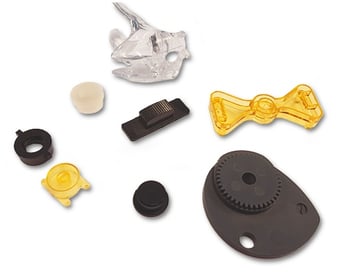 Thermoplastic injection molding is a common process used for the mass production of parts by using specialized machines. The technique works by injecting molten thermoplastic resin into a mold under high pressure, where it is held until cooled into solid form. If you have ever been curious to learn more about this important process, then you are in luck! Read through this guide and discover what is possible with thermoplastic injection molding.
Thermoplastic injection molding is a common process used for the mass production of parts by using specialized machines. The technique works by injecting molten thermoplastic resin into a mold under high pressure, where it is held until cooled into solid form. If you have ever been curious to learn more about this important process, then you are in luck! Read through this guide and discover what is possible with thermoplastic injection molding.
Injection Molding 101: When to Use Thermoplastic Injection Molding
Given its incredibly versatile nature, injection molding is often the molding method of choice for a variety of parts. While injection molding is not an overly complex production method, it caters to a wide range of part sizes and shapes. So, since it is such an adaptable manufacturing technique, what kinds of projects would benefit most from thermoplastic injection molding?
Use Thermoplastic Injection Molding When Your Project Requires Accuracy
One of the key advantages of thermoplastic injection molding is that it demonstrates high levels of accuracy, especially in comparison to alternative processes that are used for prototyping. Consistency is important when it comes to the mass production of plastic parts. Not only does thermoplastic injection molding accomplish this task of accuracy and consistency, it simultaneously reduces waste with its highly efficient setup, making it perfect for large volume projects.
Use Thermoplastic Injection Molding When Your Project Requires Quality Surface Finish
Thermoplastic injection molding can be performed to either produce a polished surface finish or a grip-friendly textured surface finish, depending on your part’s cosmetic requirements.
Use Thermoplastic Injection Molding When Your Project Requires Mechanical Strength
3D printing can produce a working prototype for many uses, but they seldom have the strength that comes from thermoplastic injection molding. In thermoplastic injection molding, you have one homogeneous product with all the mechanical characteristics you are looking for.
Use Thermoplastic Injection Molding When Your Project Involves Volume
Prototype tooling, machining, and 3D printing can be good options for low-volume production, but they seldom scale to higher volume. Further, those manufacturing methods can take more time which can create a bottleneck in your operations. For a rough rule of thumb, if you need more than 1000 pieces, thermoplastic injection molding can be an attractive option.
Potential Limitation of Thermoplastic Injection Molding
One thing to keep in mind when investing in thermoplastic injection molding is that the upfront tooling costs can be on the higher end. However, in the long run, thermoplastic injection molding still proves to be cost-effective as it provides a precise, waste-reducing way to produce large volumes of plastic parts. Additionally, to support injection molding, some design changes from machining and 3D printing may be necessary. Consistent wall thickness, draft, and undercuts are just a few factors to consider. Let your molder help you through this to make sure you get what you need.

 SINCE 1993 MADE IN USA
SINCE 1993 MADE IN USA 

